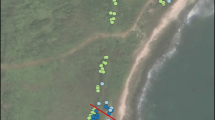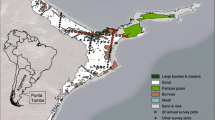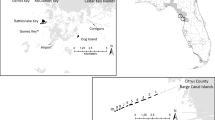Abstract
Invasive ants are a significant conservation concern and can have far-reaching effects in ecosystems they invade. We used the experimental control of ant numbers on two pairs of small (<5 ha) offshore islets dominated by either the big-headed ant, Pheidole megacephala or the tropical fire ant, Solenopsis geminata to investigate the influence of these species on seabird hatching success, fledging success and weight. Limited unpublished observations of both ant species attacking nesting seabirds exist, but the frequency of attacks or how they affect seabird growth and survival are unknown. Island-wide treatments with hydramethylnon resulted in the eradication of P. megacephala and the temporary reduction of S. geminata densities. No difference in hatching success, growth, or fledging success of Wedge-tailed Shearwaters (Puffinus pacificus), a common colonial nesting seabird in the Hawaiian Islands was observed on the pair of islets dominated by P. megacephala. On islets dominated by S. geminata, ant control resulted in a temporary increase in fledging success. Injury frequency increased dramatically on the untreated islet (8.3–100%) while remaining the same on the treated islet (27–38%). Severely injured chicks (i.e., chicks that lost >20% of tissue on their feet) weighed significantly less than uninjured chicks and did not fledge. It is unclear if the chicks were being preyed upon or stung in defense of nearby ant colonies. Radical changes in invasive ant populations have been noted, and booming ant populations could cause short-term, but widespread damage to seabird colonies. The negative effects of invasive ants on seabirds may be difficult to detect, and therefore unknown or underestimated throughout the world where the two groups overlap.





Similar content being viewed by others
References
Allen CR, Rice KG, Wojcik DP, Percival HF (1997) Effect of red imported fire ant envenomization on neonatal American alligators. J Herpetol 31:318–321
Allen CR, Willey R, Myers P, Horton P, Buffa J (2000) Impact of red imported fire ant infestation on northern bobwhite quail abundance trends in southeastern United States. J Agric Urban Entomol 17:43–51
Allen CR, Forys EA, Rice KG, Wojcik DP (2001) Effects of fire ants (Hymenoptera: Formicidae) on hatching turtles and prevalence of fire ants on sea turtle nesting beaches in Florida. Fla Entomol 84:250–253
Bach CE (1991) Direct and indirect interactions between ants (Pheidole megacephala), scales (Coccus viridis) and plants (Pluchea indica). Oecologia 87:233–239
Cole FR, Medeiros AC, Loope LL, Zuehlke WW (1992) Effects of the Argentine ant on arthropod fauna of Hawaiian high-elevation shrubland. Ecology 73(4):1313–1322
Drees B (1994) Red imported fire ant predation on nestling colonial waterbirds. Southwest Entomol 19:355–359
Feare C (1999) Ants take over from rats on Bird Island, Seychelles. Bird Conserv Int 9:95–96
Fisher RN, Suarez AV, Case TJ (2002) Spatial Patterns in the Abundance of the Coastal Horned Lizard. Conser Biol 16(1):205–215
Fukami T, Wardle DA, Bellingham PJ, Mulder CP, Towns DR, Yeates GW, Bonner KI, Durrett MS, Grant-Hoffman MN, Williamson WM (2006) Above- and below-ground impacts of introduced predators in seabird-dominated island ecosystems. Ecol Lett 9(12):1299
Gerlach J (2004) Impacts of the invasive crazy ant Anoplolepis gracilipes on Bird Island, Seychelles. J Insect Conserv 8:15–25
Gillespie RG, Reimer N (1993) The effect of alien predatory ants (Hymenoptera: Formicidae) on Hawaiian endemic spiders (Aranaeae: Tetragnathidae). Pac Sci 47(1):21–33
Giuliano WM, Allen CR, Lutz RS, Demarais S (1996) Effects of red imported fire ants on northern bobwhite chicks. J Wildl Manage 60:309–313
Green PT, O’Dowd DJ, Lake PS (1997) Control of seedling recruitment by land crabs in rain forest on a remote oceanic island. Ecology 78(8):2474–2486
Hill MK, Holm K, Vel T, Shah N, Matyot P (2003) Impact of the introduced yellow crazy ant Anoplolepis gracilipes on Bird Island, Seychelles. Biodivers Conserv 12:1969–1984
Hoffmann BD, O’Connor S (2004) Eradication of two exotic ants from Kakadu National Park. Ecol Manage & Restor 5(2):98–105
Holldolbler B, Wilson EO (1990) The ants. The Belknap Press, Cambridge, Massachusetts
Holway DA, Lach L, Suarez A, Tsutsui N, Case T (2002) The causes and consequences of ant invasions. Annu Rev Ecol Syst 33:181–233
Jourdan H, Sadlier RA, Bauer AM (2001) Little fire ant invasion (Wasmannia auropunctata)as a threat to New Caledonian lizards: evidences from a Sclerophyll forest (Hymenoptera: Formicidae). Sociobiology 38:283–301
Krushelnychky P, Hodges C, Medeiros A, Loope L (2001) Interaction between the Hawaiian dark-rumped petrel and the argentine ant in Haleakala National Park, Maui, Hawaii. Stud Avian Biol 22:243–246
LaPolla JS, Otte D, Spearman LA (2000) Assessment of the effects of ants on Hawaiian crickets. J Orthoptera Res 9:139–148
Legare ML, Eddleman WR (2001) Home range size, nest-site selection and nesting success of Black Rails in Florida. J Field Ornithol 72:170–177
Lockley T (1995) Effect of imported fire ant predation on a population of the least tern: an endangered species. Southwest Entomol 20:517–519
Maron JL, Estes JA, Croll DA, Danner EM, Elmendorp SC, Buckelew SL (2006) An introduced predator alters Aleutian island plant communities by thwarting nutrient subsidies. Ecol Monogr 76:3–24
May JE, Heterick BE (2000) Effects of the coastal brown ant Pheidole megacephala (Fabricius), on the ant fauna of the Perth metropolitan region, Western Australia. Pac Conserv Biol 6:81–85
Meek PD (2000) The decline and current status of the Christmas Island shrew Crocidura attenuate trichura on Christmas Island, Indian Ocean. Aust Mammal 22:43–49
Moller H (1996) Lessons for invasion theory from social insects. Biol Conserv 78:125–142
Moulis RA (1996) Predation by the imported fire ant (Solenopsis invicta) on loggerhead sea turtle (Caretta caretta) nests on Wassaw National Wildlife Refuge, Georgia. Chelonian Conserv Biol 2:105–106
Mueller JM, Dabbert CB, Demarais S, Forbes AR (1999) Northern bobwhite chick mortality caused by red imported fire ants. J Wildl Manage 63:1291–1298
Nishida GM (ed) (1992) Hawaiian terrestrial arthropod checklist. Bishop Museum Technical Report No. 1, pp 262
O’Dowd D, Green P, Lake P (2003) Invasional ‘meltdown’ on an oceanic island. Ecol Lett 6:1–6
Reimer NJ, Beardsley JW (1990) Effectiveness of hydramethylnon and fenoxycarb for control of Pheidole megacephala (Hymenoptera: Formicidae), an ant associated with mealybug wilt of pineapple in Hawaii. J Econ Entomol 83(1):74–80
Richardson F (1948) Holes in the webs of Shearwaters. Pac Sci 2(3):224
Risch SJ, Carroll CR (1982) Effect of a keystone predaceous ant, Solenopsis geminata on arthropods in a tropical agroecosystem. Ecology 63(6):1979–1983
Smith JE, Whelan CJ, Taylor SJ, Denight ML, Stake MM (2007) Novel predator-prey interactions: is resistance futile? Evol Ecol Res 9:433–446
Stanley MC (2004) Review of the efficacy of baits used for ant control and eradication. Landcare Research Contract Report: LC0405/044
Stoddard HL (1931) The bobwhite quail, its habits, preservation and increase. Scribner, New York, pp 559
Suarez AV, Yeh P, Case TJ (2005) Impacts of Argentine ants on avian nesting success. Insectes Soc 52:378–382
Taber SW (2000) Fire ants. Texas A & M Press, College Station, Texas
Travis BV (1938) The fire ant (Solenopsis spp.) as a pest of quail. J Econ Entomol 31:649–652
Tschinkel WR (2006) The fire ants. Belknap Press of Harvard University Press, Cambridge, Massachusetts and London, England
Wilson EO (1996) Hawaii: a world without social insects. Bishop Mus Occas Pap 45:3–7
Acknowledgments
We thank the Offshore Islet Restoration Committee, United States Fish and Wildlife Service, Hawaii Invasive Species Council, Hawaii State Division of Land and Natural Resources, University of Hawaii, Manoa, Department of Ecology, Evolution, and Conservation Biology, and Hawaii Conservation Alliance for funding this project. Chris Swenson, Andy Taylor, Paul Krushelnycky, Al Samuelson, David Preston, and Frank Howarth provided technical assistance ranging from logistical support to insect identification. Don Drake, Dave Duffy, Neil Reimer, Dan Gruner and two anonymous reviewers provided thoughtful comments on drafts of this manuscript. Nori Yeung, Korie Merrill, and Reina Tong devoted enormous amounts of time to sorting insect samples. We are grateful to Jaap and Heather Eijzenga, Alex Handler, Pat Aldrich, Ethan Shiinoki, Norma Bustos, Anneleise Andrews, Anne Devereaux, Meaghan Laut, Clay Trauernicht, Naomi Hoffman, Steph Joe and Mahina Lee-Chung for help in the field.
Author information
Authors and Affiliations
Corresponding author
Rights and permissions
About this article
Cite this article
Plentovich, S., Hebshi, A. & Conant, S. Detrimental effects of two widespread invasive ant species on weight and survival of colonial nesting seabirds in the Hawaiian Islands. Biol Invasions 11, 289–298 (2009). https://doi.org/10.1007/s10530-008-9233-2
Received:
Accepted:
Published:
Issue Date:
DOI: https://doi.org/10.1007/s10530-008-9233-2




